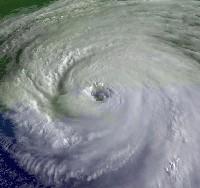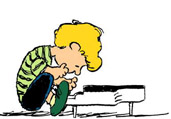Report from New Orleans
Saturday, September 10, 1:30 AM, we woke up to go back into New Orleans. Five of us, including my wife and in-laws, drove a minivan filled with gas tanks and donated supplies from Pensacola in the middle of the night. The plan was to arrive in New Orleans as soon as the 6 PM to 6 AM curfew was lifted. We would first try to get to Algiers on the west bank of the Mississippi to inspect my mother-in-law’s house, clean the refrigerator of rotting food, and pick up more clothes and personal valuables. Then, we would attempt the comparatively more difficult task of traversing the Mississippi to get to the more damaged areas of the east bank of the river. In addition to assessing the damage to my house and cleaning out the refrigerator, we intended to pick up my wife’s car, hopefully still parked in a multi-level garage.
We left at 2 AM with a full tank of gas, conserving fuel by leaving the air conditioning off and rolling down the windows. Since we didn’t know if fuel would be available anywhere on the road, and certainly not in New Orleans, we considered it prudent to conserve as much as possible. A half tank of gas would be adequate to get to New Orleans, but there was no sense in taking chances. Additionally, we carried a few extra gas tanks in the back of the van.
The route we took was I-10 west to Slidell, bypassing the destroyed twin spans across Lake Pontchartrain by taking I-12 west to I-55 south. From I-55 we traveled a small jog to the east on I-10 to its intersection with I-310. From there, we took Highway 90 to Lapalco Blvd., and traversed Lapalco all the way to Algiers.
There was a thick sulphurous stench of rotting swamp all the way from Alabama to Mississippi and into Louisiana. There were no open gas stations or businesses anywhere in Mississippi, and many exits were blocked by barricades or vehicles. Everywhere, advertising and road signs were knocked over and scattered by the sides of the highway.
At about 5:00 in the morning west of Slidell, we pulled into an old-fashioned gas station like something out of The Andy Griffith Show – a gravel drive, a dog that ran up to greet us, flip numbers on the gas pumps, and a screen door made a “creak-smack” sound when it slammed closed. Inside, a couple of guys were talking to one another across the counter – they could have been there all night. As we chatted about what the situation was in New Orleans and the best route in, every couple of minutes, they’d spit some tobacco in a cup.
There seemed to be plenty of gas in St. Tammany Parish, where the recovery seems to be well under way. As we exited 310 onto Highway 90, we saw that there were more open gas stations in Westwego.
Few of the metal buildings that are so predominate on the West Bank were not damaged. Everywhere, metal roofs were peeled away from their structures. Trees were uprooted, power lines were down, utility poles were leaning or snapped in half, and debris was everywhere.
Military outposts were abundant in public or commercial buildings, as were checkpoints run by Louisiana State Police, various military branches, and out-of-state law enforcement agencies. I later learned that this freed up local law enforcement officers to perform actual police work. An id (which I can’t really reveal in this forum) secured our passage through the checkpoints.
Moving up Lapalco Blvd., we passed easily into Algiers. The first stop was an NOPD outpost set up in an insurance building where we dropped off provisions of food and drinks, as well as baby food and other donated items. A team of about a dozen officers were camping out there, literally. They had provisions in coolers, a large gas grill, clothes draped to dry, and boxes of water. They all looked scruffy - like they could use a decent bed and a couple of weeks of rest. Everyone was sporting the same military buzz cut.
Jefferson Parish deputies were similarly worn pretty ragged. An odd aside is that JPSO facilities were swarming with people in yellow T-Shirts, members of Church of Scientology, and were offering up their own version of relief by giving out hot dogs and massages. Among the Scientologists who reportedly turned up was Kirstie Alley.
We found Algiers to be in very decent shape, aside from wind damage. There was no water damage. Lots of shorn roofs, downed limbs and trees, and downed power lines. My in-laws house had some damaged roof tiles and siding, and the yard was a disaster. Otherwise, the worst of mess was cleaning out the refrigerator. Sporting rubber gloves, bottles of bleach solution, and face masks, we emptied the contents of the refrigerator and freezer, and buried the contents in the back yard.
Another checkpoint on the GNO bridge, but again, the proper id secured our passage. We exited at Tchoupitoulas, and traversing the corridor, passed countless military troop transports and other huge military vehicles. The damage appeared limited to downed limbs – perhaps because any wind damage had already been done by Lily earlier this year.
We noticed that a favorite spot, Roly Poly was in perfect shape. The Winn-Dixie on Tchoupitoulas might have been looted, but was then boarded up. We heard that the National Guard was posted there for a time, but there was no sign of them anymore.
We turned up Nashville Ave., and found more extensive tree damage. Some large oaks were felled by the roots, and some houses incurred damage by falling trees. Cleanup crews had already started cutting through felled trees, and had moved debris out of many streets. They had done a pretty fantastic job in a short time.
When we got to Freret Street, I was shocked by the amount of debris – junk – in the street. The receding line of flooding was only a couple of blocks up from Freret toward Claiborne Ave. I’m afraid that low-lying houses from Freret to Claiborne won’t have faired well.
The first thing we did was retrieve the Volkswagon from the Loyola parking garage where we left it to ride out the storm. We discovered the garage to be filled with military personnel who were using the garage as a makeshift garrison. Laundry hung out to dry decorated the sides of the garage. Tulane and Loyola looked to be okay for the most part, except for tree debris. It was hard to ascertain the water level around the universities, although one indicator was the boats tied off along the street. After getting the Volkswagon, he headed back down Freret Street to our house.
The anticipation of what we would find had my stomach doing spins. We were fairly certain that at some point, the flooding may have reached about three feet, but had it gone any higher?
Fortunately for us, the flooding only came up to the third step on the porch, just about a foot and a half shy of the floor. The eucalyptus (mercifully) was split at the base and leaning into the street. I’ve wanted to cut down that weed for a long time anyway. Now I have an excuse and can put in something more lasting and desirable like a live oak or magnolia.
The flooding brought in an amazing array of trash and FUNK – a mixture of jars of rotting food, tires, siding, shingles, the odd piece of wood, tree debris, shoes, and a sludge of mud, oil, and whatever else happened to be carried through the city as the water pushed through from Lake Pontchartrain. Anything that was once green was now dead and brown, covered in a stinky brown muck.
The windows were still boarded up. The roof was intact. The front door was stuck shut from humidity and required a little shoulder to get open. Inside the house, there wasn’t any of the smell we expected from rotting food. Everything was as we left it. We felt the odd misery of incredible fortune at being among the lucky few to have an untainted home to return to, while at the same time feeling guilty knowing that many of our neighbors, friends, and fellow residents wouldn’t fair nearly as well.
The central air unit, and washer and dryer in the shed will most likely all have to be replaced because they were under water. Another tree in the back yard leaned against the side of the house, but caused no damage. There was some leaking through the roof visible in stains on the ceiling. The rain must have been moving horizontal at an extremely high velocity and getting under some of the shingles. Oddly, a spring-loaded curtain rod we used to hide towels in the bathroom was lying on the floor – the only way that could have happened is if the house were moving. I’m not talking here about any modern prefab construction. I’m talking about a house built in 1919 on deep thick brick piers and solid timbers.
As with the house in Algiers, we cleaned out the refrigerator, burying the food in a hole in the yard. We grabbed a few more changes of clothes to supplement the three changes we initially brought with us, and looked for anything else we might want to salvage or need for the duration of weeks that we might not be able to return.
NOPD and State Police units passed, each asking what we were doing and how we were able to be in the city. The NOPD supervisor who passed was a little more touchy than the rest, almost to the point of hostility. A few military vehicles passed, greeting us cautiously after determining that we weren’t looters.
We were met at the house by a celebrity friend of the family (see if you can guess who) who heard we were in town.
As it was getting on toward 5:00, we wrapped up what we had to do, fueled up the van and Volkswagon, and headed for the Causeway along River Road. Entrance to the Causeway was also protected by a checkpoint.
Moving out over the Causeway, out over Lake Pontchartrain, we realized again how incredibly lucky we were. Uptown was largely saved from the greatest devastation, although I imagine that much of Uptown will also have to be rebuilt. Nevertheless, we were nowhere near the areas of greatest devastation – Lakeview, Mid-City, and the Ninth Ward, where houses were under several feet of water in some places.
Again, I felt the odd sensation of…guilt – the guilt that we fared well where others did not. We numbered among the lucky few. Our task will be to help our friends and neighbors rebuild.
New Orleans will rebuild. There’s simply too much culture in that city, too many families that have been there for generations, too many small-town connections, to allow anything to break the cohesion of the New Orleans community, of which I guess I can now claim as part of my heritage too, for better and for worse.
Photos here, and here.







4 Comments:
Wow...
You and your family were very fortunate. Although it's still going to be a pain in the hiney to replace the items that were damaged, you have a home and your loved ones are safe.
Now I'm wondering what kind of ID got you in and who the celebrity is!
You are one of the good ones, Schroeder, and I can certainly see you and your wife and in-laws helping out wherever needed.
God bless you and your family, and I'm very glad things turned out as well as they did.
(Interesting story and pictures, BTW.)
Mixter
The id answer should really be offline - just to try to keep my identity discreet from those I may wish to criticize.
As for the celebrity - he's a reporter for CNN, Ed Lavandera. He's been in New Orleans for a couple of weeks now. He usually does general assignments.
You don't really have to say. I'll just make something interesting up in my head!
I try not to discuss matters of work online anyway. My boss prefers me not to advertise who I work for, because he's afraid I may offend someone, intentionally or not. He's a great friend, though, so I don't mind honoring his request.
And no offense to your reporter friend, but I've never heard of him. Still, awfully nice of him to stop by and see how things are going.
Please keep us posted; your ongoing story is intriguing.
Mixter
Hear, hear.
Post a Comment
<< Home